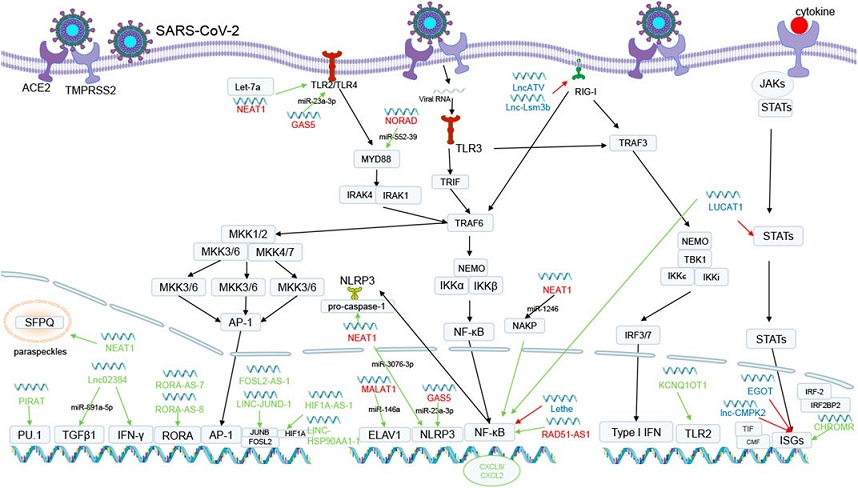BREAKING NEWS! Study Finds That Human Host lncRNAs And miRNAs Play A Role In Antiviral Response In SARS-CoV-2 Infection!
Thailand Medical - lncRNAs - miRNAs - SARS-CoV-2 Jul 28, 2023 1 year, 8 months, 2 weeks, 6 days, 14 hours, 50 minutes ago
Thailand Medical: The outbreak of coronavirus disease 2019 (COVID-19) caused by the severe acute respiratory syndrome coronavirus 2 (SARS-CoV-2) led to a global pandemic, leaving devastating effects on human health and economies worldwide. To combat this formidable pathogen, scientists have delved into understanding the intricate interactions between non-coding RNAs (ncRNAs) and viral infections. Recently, emerging evidence highlights the critical role of ncRNAs, particularly long non-coding RNAs (lncRNAs) and microRNAs (miRNAs), in regulating the antiviral immune response and influencing the course of SARS-CoV-2 infection.
 The possible mechanisms of lncRNAs in SARS-CoV-2 infection. Green lines mean upregulating expression or promoting process. Red lines mean downregulating gene expression. Green lncRNAs is antiviral response related lncRNAs. Blue lncRNAs is immune escape related lncRNAs. Red lncRNAs is cytokine storm related lncRNAs. Some lncRNAs boost antiviral responses by triggering innate or adaptive immunity or by increasing the production of antiviral components.
The possible mechanisms of lncRNAs in SARS-CoV-2 infection. Green lines mean upregulating expression or promoting process. Red lines mean downregulating gene expression. Green lncRNAs is antiviral response related lncRNAs. Blue lncRNAs is immune escape related lncRNAs. Red lncRNAs is cytokine storm related lncRNAs. Some lncRNAs boost antiviral responses by triggering innate or adaptive immunity or by increasing the production of antiviral components.
Since its initial emergence in December 2019, COVID-19 has rapidly spread across the globe, leading the World Health Organization (WHO) to declare it a public health emergency. As of June 2023, the disease has affected over 768 million people and caused more than 6.9 million deaths. The clinical manifestations of COVID-19 range from mild respiratory symptoms to severe pneumonia, acute respiratory distress syndrome (ARDS), and multi-organ dysfunction syndrome (MOD). The emergence of new variants, like the Omicron variant, has posed additional challenges, prompting the need for deeper insights into the SARS-CoV-2 infection mechanisms.
While, about two-thirds of the human genome is actively transcribed, only about 1.9% of the genome encodes proteins. NcRNAs, which fall outside this protein-coding fraction, are a diverse class of RNA molecules playing essential roles in cellular regulation. Among the regulatory ncRNAs, miRNAs, lncRNAs, circular RNAs (circRNAs), and piwi-interacting RNAs (piRNAs) have garnered significant attention. These ncRNAs have been found to be associated with the SARS-CoV-2 infection process, where they influence viral replication, host immune responses, and the onset of cytokine storms.
The Impact of lncRNAs in SARS-CoV-2 Infection
Research has shown that SARS-CoV-2 infection leads to altered expression profiles of host lncRNAs, which in turn affect the expression of antiviral genes and the replication of viral genes. Some lncRNAs contribute to the innate and adaptive immune responses, while others are co-opted by the virus to evade the host's immune system. Various studies have identified differentially expressed lncRNAs associated with immune evasion, cytokine storms, and antiviral responses in SARS-CoV-2 infection. For instance, lncRNAs such as NEAT1 and MALAT1 have been shown to modulate the inflammatory response and cytokine production.
Mechanistically, some lncRNAs directly bind to the SARS-CoV-2 genome, influencing viral replication. Others act as transcriptional enhancers of immune-related genes or sequester miRNAs to control the expression of critical cytokines. The involvement of lncRNAs in regulating the RIG-I pathway, NF-κB signaling, and JAK-STAT pathway highlights their multi-faceted roles in modulating the
host's response to SARS-CoV-2 infection. Despite significant progress, much remains to be explored in this burgeoning field.
MicroRNAs as Key Players in SARS-CoV-2 Infection
MicroRNAs are small ncRNAs that post-transcriptionally regulate gene expression by binding to target messenger RNAs (mRNAs). Studies have shown that specific miRNAs are differentially expressed in response to SARS-CoV-2 infection, potentially affecting viral replication and the host's immune response. Certain miRNAs, like miR-146a-5p, miR-21-5p, and miR-142-3p, are consistently downregulated, while miR-3605-3p is consistently upregulated in COVID-19 patients. Understanding the mechanisms behind these changes is crucial for developing targeted therapies.
Lead research, Lead researcher, Dr Chenguang Shen, a Professor at Southern Medical University, Guangzhou-China told
Thailand Medical News, “MicroRNAs have been found to regulate both innate and adaptive immunity in response to viral infection. Some miRNAs enhance the initiation of innate immune responses triggered by type I interferons, while others promote T cell activation and differentiation to bolster the adaptive immune response against SARS-CoV-2. Conversely, certain miRNAs can be hijacked by the virus to suppress the host's immune response, promoting immune evasion.”
Unraveling the Cytokine Storm
In severe cases of COVID-19, a cytokine storm ensues, characterized by an excessive release of pro-inflammatory cytokines. MiRNAs, like miR-155-3p, miR-139-5p, and miR-146a-5p, play a role in modulating the expression of cytokines associated with the cytokine storm. Understanding the regulatory mechanisms of these miRNAs could pave the way for potential therapies targeting the cytokine storm and its devastating consequences.
Conclusion
Research exploring the intricate interplay between human host ncRNAs and SARS-CoV-2 infection has provided invaluable insights into the immune response and viral pathogenesis. The roles of lncRNAs and miRNAs in antiviral response, immune evasion, and cytokine storm have expanded our understanding of the complex interactions between host and virus. As scientists continue to unravel the mysteries of ncRNA regulation, the potential for developing novel diagnostic and therapeutic approaches against COVID-19 and future viral infections becomes increasingly promising. The study of ncRNAs in the context of SARS-CoV-2 infection holds immense potential to revolutionize our approach to viral diseases, offering hope for a healthier and more resilient future.
The study findings were published in the peer reviewed journal: Frontiers In Cell And Developmental Biology
https://www.frontiersin.org/articles/10.3389/fcell.2023.1229393/full
For the latest on COVID-19 Research, keep on logging to
Thailand Medical News.
